Pride of Madiera is the Common name given to the Echium fatuosum, and as the name suggests, it is native to the Island of Madiera. This is a large perennial plant with rough , raspy textured leaves, and large blue flowers spikes in Spring to early Summer.
There are a number of varieties of Echium, and they are all spectacular when in flower, adding a distinct shape in a garden which contrasts to other plants. The plants grow to around 2.5 metres tall, and around 2 metres wide, and are drought tolerant once established. The best climate for these is temperate to warm, preferably with low humidity, although Sydney can be quite humid in Summer, and these plants still look good. Plant them in a position with full sun and well drained soil. Prune off old flower heads and leggy stems to keep the plant compact. They grow fast, so they will look good again in no time.
I took these photos in gardens close to Sydney Harbour. 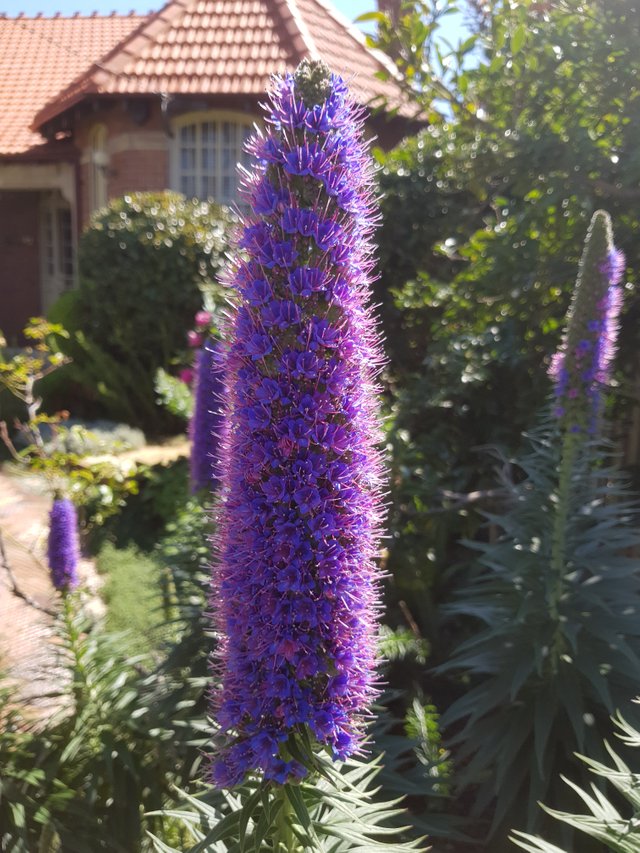
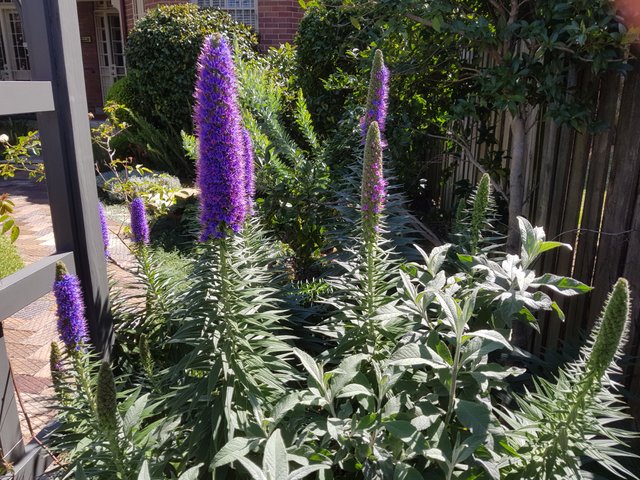
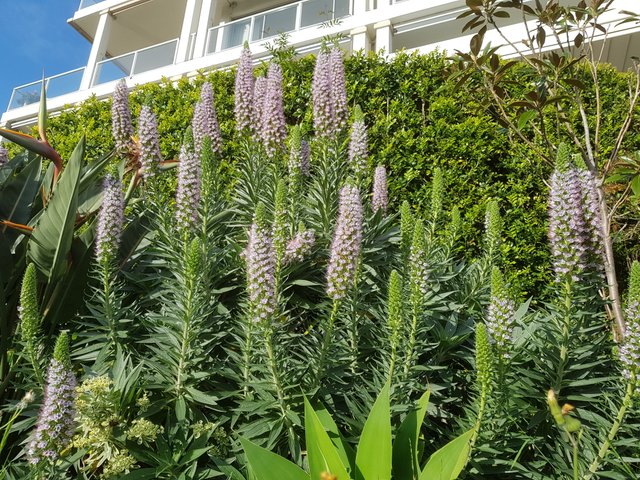
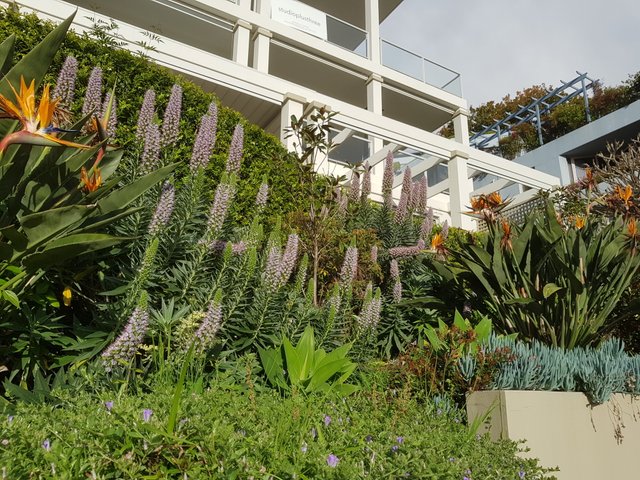
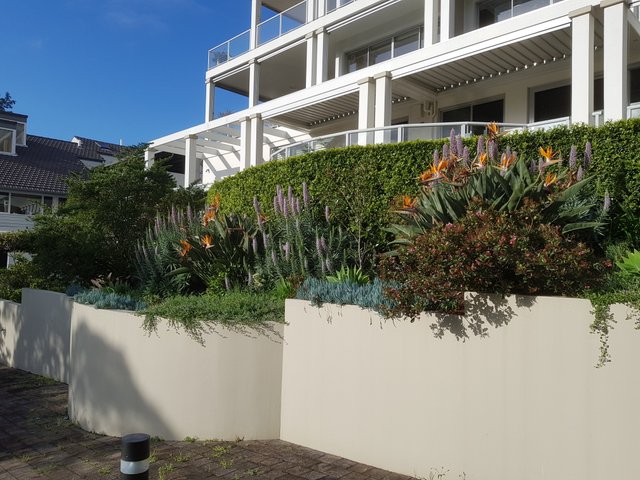
A very beautiful plant. I fell in love with it. It really is the pride of all the representatives of this family. Pride of Madeira. This delightful and hardy perennial produces large spires of sapphire blue to violet flowers with crimson stamens in spring and summer. Best grown in the ground and

great in cottage gardens or in mixed borders. Grows well in coastal areas and is great for bees.
Thank you for the wonderful plants.
https://inlandvalleygardenplanner.org/plants/page/15/
Downvoting a post can decrease pending rewards and make it less visible. Common reasons:
Submit
Fav. comment Award ! Nice choice of Pics, well done.
Downvoting a post can decrease pending rewards and make it less visible. Common reasons:
Submit
Madeira's pride is a beautiful and amazing plant. This is truly dramatic with spectacular high flower spikes.
This beautiful plant needs one season for flower germination so it will flower in the first year and so on.
After the flower is formed, Madeira's pride will produce its own seeds productively. Unless we have winter, we will never plant again because we will always have lots of seeds.
In the first year, Madeira's pride will grow by about one meter and in the second year will produce fantastic flowers.
Absolutely spectacular!
Source
Downvoting a post can decrease pending rewards and make it less visible. Common reasons:
Submit
Fav. comment Award ! Excellent Pics, thanks.
Downvoting a post can decrease pending rewards and make it less visible. Common reasons:
Submit
We love that this old classic is coming back in popular demand. The Pride of Madeira is an excellent prolific flowering plant with gorgeous and tall purple flowers.If you’re looking for a low maintenance flowering plant with maximum impact, this plant might be just what you’re after. It’s a perennial and grows excellently in Australian coastal areas, requiring minimal watering and care.

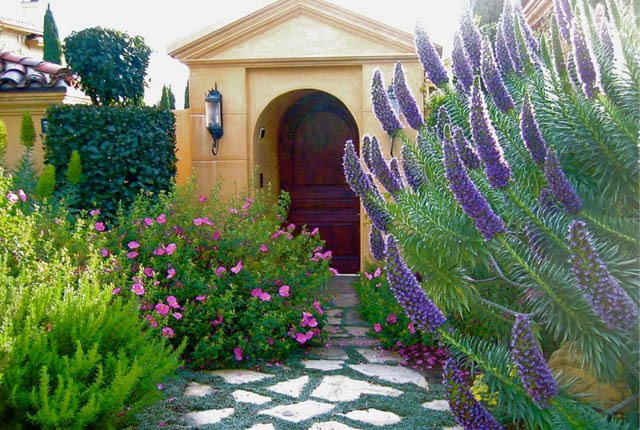
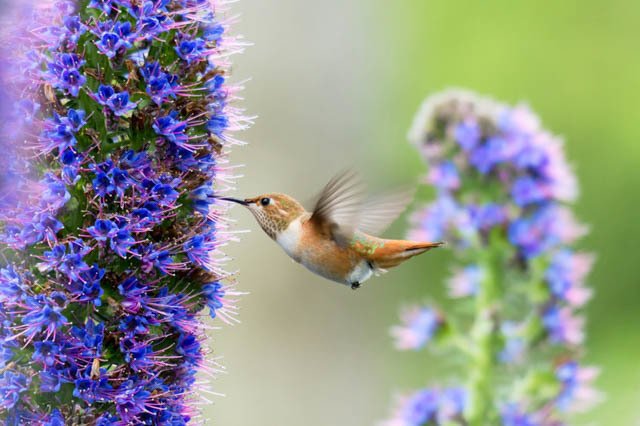 .
.
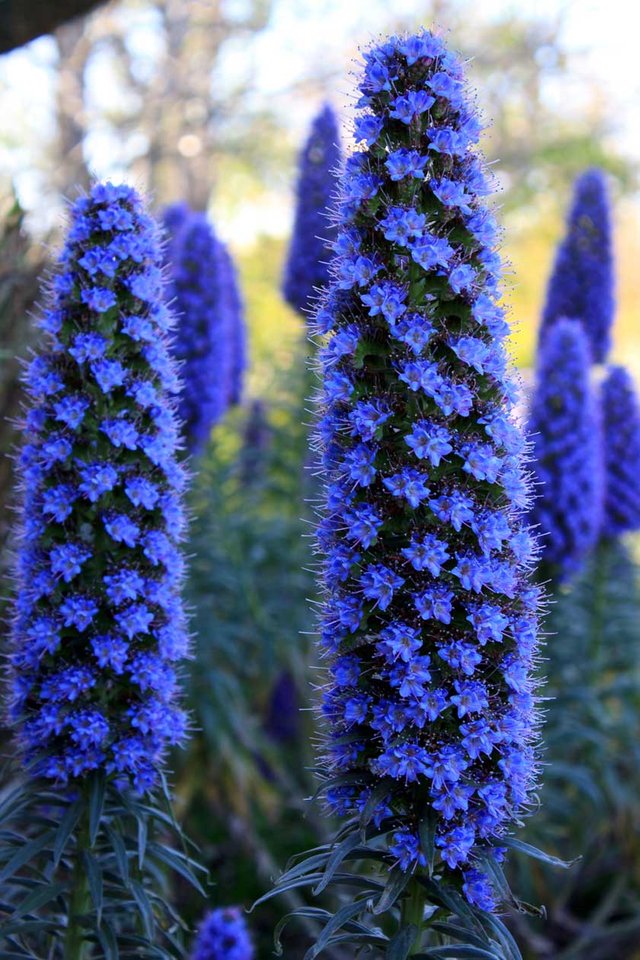
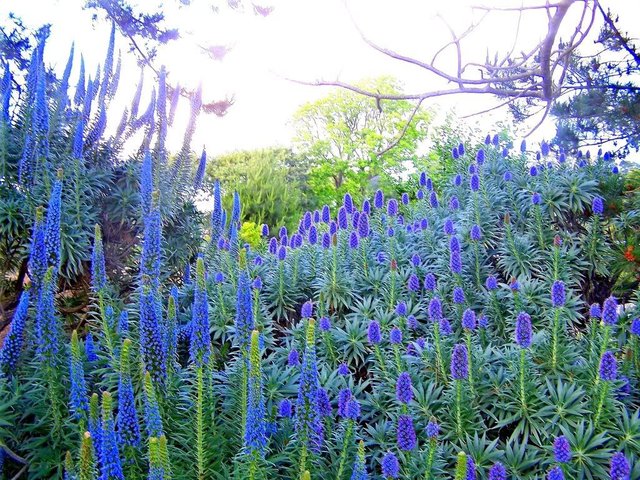
Reaching a maximum of about 3 metres tall and 2 meters wide, the Echium Candicans grows best in full sun. Soil should be well drained and not too rich or moist. For care, once flowering has finished prune off the flower spikes. This will encourage growth of more branches for next.
 - A rapidly growing evergreen shrub to 4 to 6 feet or more tall or more by as wide with long, narrow, gray-green leaves held at the ends of the branches. Rising above the foliage in spring on into early summer are the large 20 inch long flower stalks bearing small bluish-purple flowers with reddish stamens. Plant in full sun in most any type of soil and irrigate occasionally to not at all. Once established plants require no additional irrigation in coastal gardens though inland plantings will appreciate occasional irrigation and protection from cold - reliably cold hardy for short durations down to about 25 degrees F and some claim a bit colder. This is a great plant for mild coastal climates and seaside gardens on a slope or in an area with room to spread out and it is attractive to honey bees, hummingbirds and butterflies, but unpalatable to deer and other browsers. Pride of Madeira often reseeds itself in the garden and, as this plant is relatively short lived (generally 4-6 years but some living up to 10 years), allow seedlings to replace older woodier plants. Prune flower inflorescences off after flowering to tidy up the plant and cut back hard in late fall to reduce size and encourage new growth from lower branches - leaves have slightly irritating hairs so remember to wear gloves when handling.
https://www.smgrowers.com/products/plants/plantdisplay.asp?plant_id=543
Downvoting a post can decrease pending rewards and make it less visible. Common reasons:
Submit
Twelve inch spikes of countless purple-blue flowers open on strong branching stems in spring and summer, although very few good seeds are often produced. This really is a perennial in a sheltered situation, e.g. in a large pot or a very protected garden. In The Scilly Islands and the South West of the UK this plant often makes a long-lived small tree.
Seeds are best sown in spring or before mid summer to enable a full season of growth and are best sown where actually needed, preferably in a well-drained and sheltered spot. Otherwise, sow seeds, covering very thinly, in early spring onto a good soil-based compost in a frost-free place. No artificial heat is needed to help germinate these seeds, just a cool, varying, background temperature, in good light. Seedlings usually appear in 3 to 4 weeks. Pot on into a gritty compost containing very little organic material before planting out as small plants in a well-drained sheltered spot, or a large container that may be taken in during the winter in severe frost. Plants usually flower 24 months after sowing and can occasionally vary in habit and flower colour as we have numerous species growing here, and very many busy bees.
https://www.plant-world-seeds.com/store/view_seed_item/447
Downvoting a post can decrease pending rewards and make it less visible. Common reasons:
Submit
@ctrl-alt-nwo,
Wow it's beautiful! Uncommon in Sri Lanka! Actually I never see this plant and flower here! It seems to be a good plant for gardening and your photography has proven it! Thank you for sharing such great photography and description about "Pride of Madiera"!
Cheers~
Downvoting a post can decrease pending rewards and make it less visible. Common reasons:
Submit
Congratulations @ctrl-alt-nwo!
Your post was mentioned in the Steemit Hit Parade in the following category:
Downvoting a post can decrease pending rewards and make it less visible. Common reasons:
Submit
Beautiful plant, my friend, a truly dramatic garden plant, a close relative of borage, it produces the most spectacular tall flower spikes seemingly from nowhere in summer. Despite it's common name of 'Pride of Madeira', it is hardy in the UK down to -5C or so, particularly where it is drier in winter. It is biennial, so needs one cold winter after germination to flower - so these plants will flower in their first year and beyond.
Once your echium has established and flowered, it will self-seed prolifically and, unless we have a really harsh winter, you will never have to plant another as you will always have plenty of seedlings!
E. candicans will grow to around 1m (3ft) in its first year, then in its second, it produces its magnificent flower - in milder areas the plants keep growing all year around and, after a frost-free winter, you will see enormous flower spikes. Plants are not frost hardy, and the leaves are easily blackened by cold winds so protect seedlings and one-year old plants if frost threatens.
A common sight in Cornwall as well, Echiums are best grown in very well drained soils, or in large pots with plenty of sand or grit for drainage. When it does grow in spring, keep it well watered between May and August as it grows quickly.
Echiums self-seed over a small area, and once these seedlings have germinated and over-wintered, they too may flower away, and a little colony will appear. Truly spectacular and one of the best plants that you can grow to attract pollinating insects into your garden.
Thank you @ctrl-alt-nwo
A source of information: https://www.yougarden.com/item-p-680023/pride-of-madeira-echium-candicans
Downvoting a post can decrease pending rewards and make it less visible. Common reasons:
Submit
Thanks again for sharing some great photos.
Shared on twitter promoting #Steemit.
Have a great weekend.
Stephen
Pride of Madiera. #STEEM #steemtalent #JoinSteemit #Steemit
#garden #gardening #gardensworld #plant #life #blog #blogger #australia #photography #photographer
https://twitter.com/StephenPKendal/status/105583062024765440
Downvoting a post can decrease pending rewards and make it less visible. Common reasons:
Submit
A truly dramatic garden plant, a close relative of borage, it produces the most spectacular tall flower spikes seemingly from nowhere in summer. Despite it's common name of 'Pride of Madeira', it is hardy in the UK down to -5C or so, particularly where it is drier in winter. It is biennial, so needs one cold winter after germination to flower - so these plants will flower in their first year and beyond.
E. candicans will grow to around 1m (3ft) in its first year, then in its second, it produces its magnificent flower - in milder areas the plants keep growing all year around and, after a frost-free winter, you will see enormous flower spikes. Plants are not frost hardy, and the leaves are easily blackened by cold winds so protect seedlings and one-year old plants if frost threatens.
A common sight in Cornwall as well, Echiums are best grown in very well drained soils, or in large pots with plenty of sand or grit for drainage. When it does grow in spring, keep it well watered between May and August as it grows quickly.
Echiums self-seed over a small area, and once these seedlings have germinated and over-wintered, they too may flower away, and a little colony will appear. Truly spectacular and one of the best plants that you can grow to attract pollinating insects into your garden.
Source
Downvoting a post can decrease pending rewards and make it less visible. Common reasons:
Submit
An exotic shrub. That should be any oxymoron. How could something as exotic and beautiful as this be described as something as dull as 'a shrub'? This can. No alternative. It's woody and the trunk and branches tend to create the most wonderful shapes under its canopy of floppy glaucous leaves and in early spring starts producing it's crowd of perpendicular electric blue flower spikes. Fully out in April. The plant might reach 6ft or more (still doesn't qualify as a tree) and 6ft across and the flowers about 1ft tall. If you have a garden mild enough for this (within 200 metres of the beech or Central London), one of its many engaging traits is its tendency to produce the flowers even in the depths of winter. A harbinger of spring, a nice reminder that winter won't last forever. It's just before Christmas as I write and the plants at the nursery (in the unheated greenhouse) are already making it obvious where they're going to flower.
It needs plenty of light, good ventilation and a reasonably well drained soil. If you can give it winter protection (a shed or greenhouse), try it in a pot but make it as big as you can manage. They grow quite fast but don't live particular long (10 years?). A roof garden in Central London... The main one pictured is in Linda's garden in Felpham - 100 yards from the beach. Linda is our Niwaki expert.
Source: http://architecturalplants.com/plants/id/echium-fastuosum
Downvoting a post can decrease pending rewards and make it less visible. Common reasons:
Submit
An exotic shrub. That should be any oxymoron. How could something as exotic and beautiful as this be described as something as dull as 'a shrub'? This can. No alternative. It's woody and the trunk and branches tend to create the most wonderful shapes under its canopy of floppy glaucous leaves and in early spring starts producing it's crowd of perpendicular electric blue flower spikes. Fully out in April. The plant might reach 6ft or more (still doesn't qualify as a tree) and 6ft across and the flowers about 1ft tall. If you have a garden mild enough for this (within 200 metres of the beech or Central London), one of its many engaging traits is its tendency to produce the flowers even in the depths of winter. A harbinger of spring, a nice reminder that winter won't last forever. It's just before Christmas as I write and the plants at the nursery (in the unheated greenhouse) are already making it obvious where they're going to flower.
http://architecturalplants.com/plants/id/echium-fastuosum
Downvoting a post can decrease pending rewards and make it less visible. Common reasons:
Submit
Reaching a maximum of about 3 metres tall and 2 meters wide, the Echium Candicans grows best in full sun. Soil should be well drained and not too rich or moist. For care, once flowering has finished prune off the flower spikes. This will encourage growth of more branches for next season!
We like the idea of making a bold colour and size statement with this plant. Once you see this plant in all it’s glory, well placed in any garden setting, it is hard to forget. We recommend planting the Pride of Madeira in an area which allows plenty of space for it to grow. We would also advise planting it at the back of your garden beds so it doesn’t over shade other plants.
Source
Downvoting a post can decrease pending rewards and make it less visible. Common reasons:
Submit
Those look even beautiful in the long fields when they are at their best beautiful to check out about it
Downvoting a post can decrease pending rewards and make it less visible. Common reasons:
Submit
Very nice deep colour flowers! This will grow up to two meters! But it requires a lot of work too.
Posted using Partiko iOS
Downvoting a post can decrease pending rewards and make it less visible. Common reasons:
Submit
Still a beautiful plant @ctrl-alt-nwo despite its unusual raspy shape but the colors are stunning if you look closely on the flowers.
Downvoting a post can decrease pending rewards and make it less visible. Common reasons:
Submit
Fantastic. I never even imagined a plant like this looks artificial but very beautiful.
Downvoting a post can decrease pending rewards and make it less visible. Common reasons:
Submit
@ctrl-alt-nwo, What can i say about this plant, just wow and awesome. This plant have beautiful and very unique Set of flowers for sure. And i want to call these flowers as Cone Flowers. And whenever we watch these kind of Natural Artistic Creations then in my opinion it reflects as nature created these plants to grow the pure and natural Decorative Pieces. And in these pictures we can see that how beautifully these plants are enhancing the house and for sure these pictures will going to encourage others to adopt the Home Based Plantation idea. Keep capturing and sharing healing aspects of nature.
Wishing you an great day and stay blessed. 🙂
Downvoting a post can decrease pending rewards and make it less visible. Common reasons:
Submit
ECHIUM 'BLUE DWARF'
KEY FACTS
Family:Boraginaceae
Common name:Echium fastuosum hybrid
Classification:Half hardy perennial
Height:1.0-1.3m
Packet Content:15 (Approx)
DESCRIPTION
This dazzling, completely new, diminutive form of this delightful plant appeared by chance in our gardens at Plant World. Probably an Echium fastuosum/pininana hybrid, it is best grown under the shelter of a hedge or wall and facing the sun, where it makes a low mound of several hairy, grey-green rosettes on numerous branching stems. Stumpy, fat spikes of cobalt-blue flowers open from April to June producing an awe-inspiring spectacle. To perform well it needs protection from cold winds and severe frost though! A limited number of good seeds were collected. (All of our echiums are grown in the same large gardens at Plant World, so you may occasionally have a % of hybrids.)
SOWING ADVICE
Seeds are best sown in spring or before mid summer to enable a full season of growth and are best sown where actually needed, preferably in a well-drained and sheltered spot. Otherwise, sow seeds, covering very thinly, in early spring onto a good soil-based compost in a frost-free place. No artificial heat is needed to help germinate these seeds, just a cool, varying, background temperature, in good light. Seedlings usually appear in 3 to 4 weeks. Pot on into a gritty compost containing very little organic material before planting out as small plants in a well-drained sheltered spot, or a large container that may be taken in during the winter in severe frost. Plants usually flower 24 months after sowing and can occasionally vary in habit and flower colour as we have numerous species growing here, and very many busy bees....
https://www.plant-world-seeds.com/store/view_seed_item/4777
Downvoting a post can decrease pending rewards and make it less visible. Common reasons:
Submit
Echium fastuosum
An exotic shrub. That should be any oxymoron. How could something as exotic and beautiful as this be described as something as dull as 'a shrub'? This can. No alternative. It's woody and the trunk and branches tend to create the most wonderful shapes under its canopy of floppy glaucous leaves and in early spring starts producing it's crowd of perpendicular electric blue flower spikes.
Fully out in April. The plant might reach 6ft or more (still doesn't qualify as a tree) and 6ft across and the flowers about 1ft tall. If you have a garden mild enough for this (within 200 metres of the beech or Central London), one of its many engaging traits is its tendency to produce the flowers even in the depths of winter.
A harbinger of spring, a nice reminder that winter won't last forever. It's just before Christmas as I write and the plants at the nursery (in the unheated greenhouse) are already making it obvious where they're going to flower.
It needs plenty of light, good ventilation and a reasonably well drained soil. If you can give it winter protection (a shed or greenhouse), try it in a pot but make it as big as you can manage. They grow quite fast but don't live particular long (10 years?). A roof garden in Central London.
References12345
Downvoting a post can decrease pending rewards and make it less visible. Common reasons:
Submit
Echium candicans (syn. Echium fastuosum is commonly known as pride of Madeira, is a species of flowering plant in the family Boraginaceae, native to the island of Madeira. It is a large herbaceous Perennial subshrub, growing to 1.5–2.5 m.
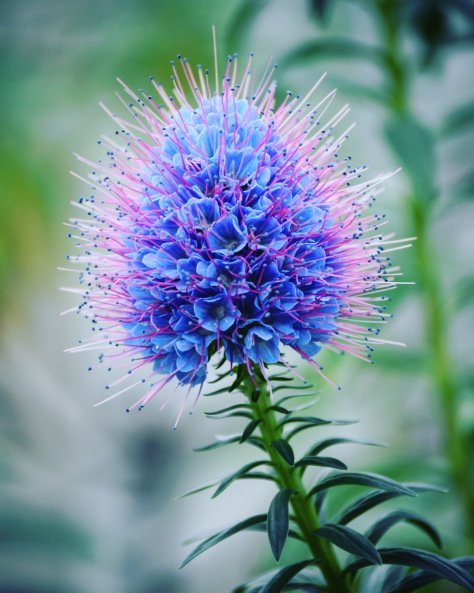
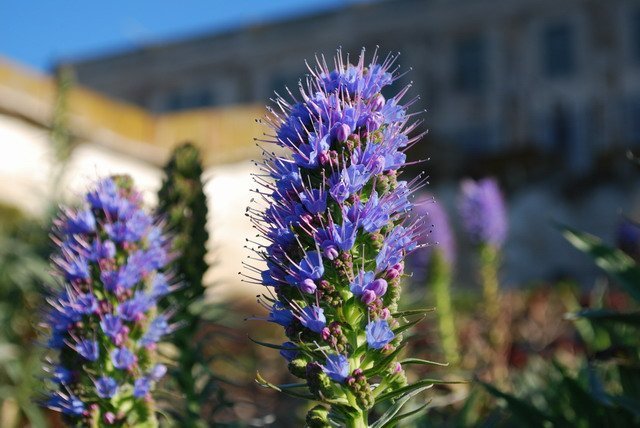
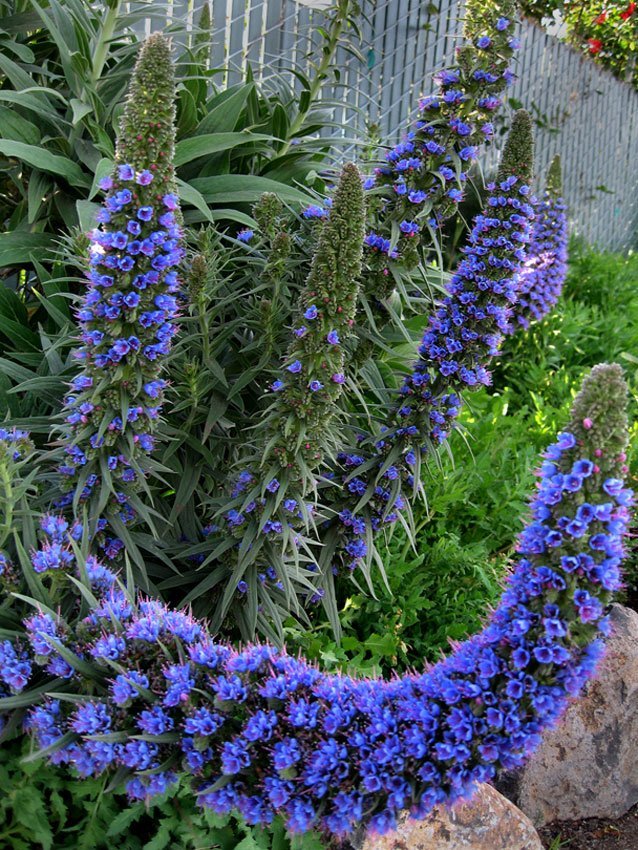
Source
Source
Source
In the first year after germination the plant produces a broad rosette of leaves. In the second and subsequent years more or less woody flowering stalks are produced clothed in rough leaves. The flower head is large and covered with white or blue flowers having red stamens. It is much visited by bees and butterflies for its nectar.
Source
Downvoting a post can decrease pending rewards and make it less visible. Common reasons:
Submit
magoo-2 found a series of multi accounts of a same owner is following your articles to cheat your generous rewards.
magoo-2 found these accounts are suspicious & can be multi accounts of a single owner. Conclusion is based on last 1 year transactions:
@alves
@devid1996
@mhyeasin
@sadikulaziz
@msena
@kilee
@ripon1
@googlefighter
@melianasagita
@ashasikder
@hichako
magoo-2
Check our latest multi comment spam update report
Downvoting a post can decrease pending rewards and make it less visible. Common reasons:
Submit
Echium fastuosum
An exotic shrub. That should be any oxymoron. How could something as exotic and beautiful as this be described as something as dull as 'a shrub'? This can. No alternative. It's woody and the trunk and branches tend to create the most wonderful shapes under its canopy of floppy glaucous leaves and in early spring starts producing it's crowd of perpendicular electric blue flower spikes. Fully out in April. The plant might reach 6ft or more (still doesn't qualify as a tree) and 6ft across and the flowers about 1ft tall. If you have a garden mild enough for this (within 200 metres of the beech or Central London), one of its many engaging traits is its tendency to produce the flowers even in the depths of winter. A harbinger of spring, a nice reminder that winter won't last forever. It's just before Christmas as I write and the plants at the nursery (in the unheated greenhouse) are already making it obvious where they're going to flower.
It needs plenty of light, good ventilation and a reasonably well drained soil. If you can give it winter protection (a shed or greenhouse), try it in a pot but make it as big as you can manage. They grow quite fast but don't live particular long (10 years?). A roof garden in Central London... The main one pictured is in Linda's garden in Felpham - 100 yards from the beach. Linda is our Niwaki expert.
For information and ideas on winter protection go to 64. Wrapping for Winter in the Glossary of Terms.
Propagated by us from seed.
http://architecturalplants.com/plants/id/echium-fastuosum
Downvoting a post can decrease pending rewards and make it less visible. Common reasons:
Submit
Nice, i didn't know this before looking very nice
Downvoting a post can decrease pending rewards and make it less visible. Common reasons:
Submit
It maybe Beautiful but consider as Weeds in the state of Victoria.
Downvoting a post can decrease pending rewards and make it less visible. Common reasons:
Submit
@ctrl-alt-nwo beautiful photo I've born in Portugal and I suggest another lovely flower from Madeira Island.
The Strelitzia reginae flower has a unique shape similar to the head of a bird, hence also known as the Bird of Paradise.
It is the national flower of Madeira, Portugal since 2005.
Posted using Partiko Android
Downvoting a post can decrease pending rewards and make it less visible. Common reasons:
Submit
2,5 meters is high, but beautiful👍
Downvoting a post can decrease pending rewards and make it less visible. Common reasons:
Submit
Delightful plant. One of the most unusual plants I've ever seen.
Downvoting a post can decrease pending rewards and make it less visible. Common reasons:
Submit
Echium fastuosum is an exotic shrub. That should be any oxymoron. How could something as exotic and beautiful as this be described as something as dull as 'a shrub'? This can. No alternative. It's woody and the trunk and branches tend to create the most wonderful shapes under its canopy of floppy glaucous leaves and in early spring starts producing it's crowd of perpendicular electric blue flower spikes. Fully out in April. The plant might reach 6ft or more (still doesn't qualify as a tree) and 6ft across and the flowers about 1ft tall. If you have a garden mild enough for this (within 200 metres of the beech or Central London), one of its many engaging traits is its tendency to produce the flowers even in the depths of winter. A harbinger of spring, a nice reminder that winter won't last forever. It's just before Christmas as I write and the plants at the nursery (in the unheated greenhouse) are already making it obvious where they're going to flower.
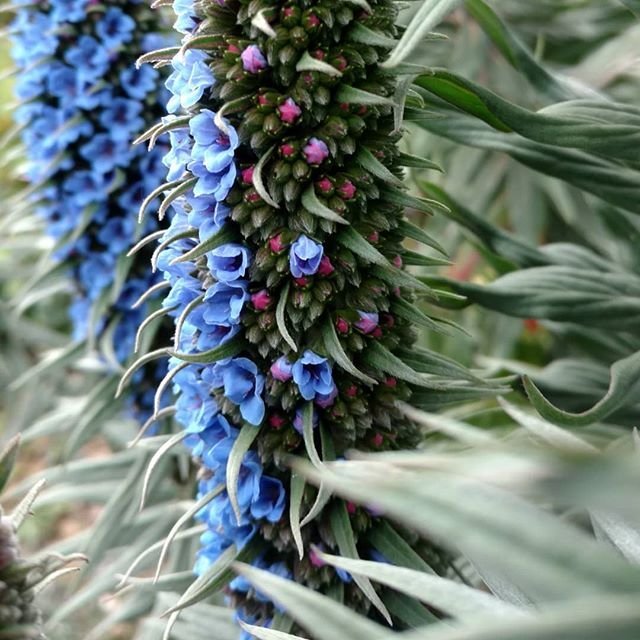
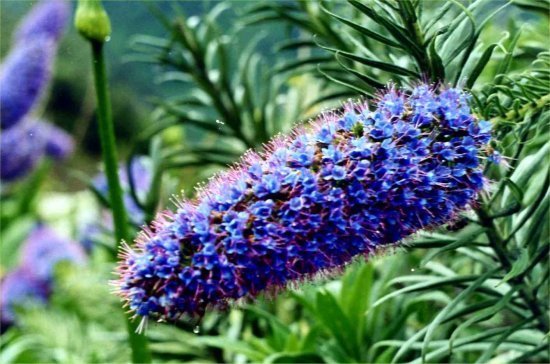
image source
image source
It needs plenty of light, good ventilation and a reasonably well drained soil. If you can give it winter protection (a shed or greenhouse), try it in a pot but make it as big as you can manage. They grow quite fast but don't live particular long.
content source
Downvoting a post can decrease pending rewards and make it less visible. Common reasons:
Submit
Pride of Madeira
Echium candicans, a dicot, is a shrub that is not native to California; it was introduced from elsewhere and naturalized in the wild.
Location Suitability
Distribution by County
Family: BORAGINACEAE
Genus: Echium
https://www.calflora.org/cgi-bin/species_query.cgi?where-calrecnum=2888
Downvoting a post can decrease pending rewards and make it less visible. Common reasons:
Submit
Huge, dramatic, blue-purple spikes appear on the end of upward curving branches in Spring. Does well in POOR, DRY SOIL, but does need drainage. 3’-6’ tall and wide. No summer water in Sunset Zones 16-17 needed once established. Native to the Madeira Island, north of the Canary Islands.
Their flower spikes, each of which contains thousands of individual blossoms, attract butterflies, bees and hummingbirds in droves. You’ll see them not only in blue, but in many shades of purple and lavender, as well as a dusty pink.
https://leisureguy.wordpress.com/2010/03/20/pride-of-madeira/
Downvoting a post can decrease pending rewards and make it less visible. Common reasons:
Submit
Echium candicans (Pride of Madeira) - A rapidly growing evergreen shrub to 4 to 6 feet or more tall or more by as wide with long, narrow, gray-green leaves held at the ends of the branches. Rising above the foliage in spring on into early summer are the large 20 inch long flower stalks bearing small bluish-purple flowers with reddish stamens. Plant in full sun in most any type of soil and irrigate occasionally to not at all.
source
Downvoting a post can decrease pending rewards and make it less visible. Common reasons:
Submit
magoo-2 found a series of multi accounts of a same owner is following your articles to cheat your generous rewards.
magoo-2 found these accounts are suspicious & can be multi accounts of a single owner. Conclusion is based on last 30 days transactions:
@itamarr
@chocosteem
@berwyn
@benedetto
@bronter
@hungduan
magoo-2
Check our latest multi comment spam update report
Downvoting a post can decrease pending rewards and make it less visible. Common reasons:
Submit
We love that this old classic is coming back in popular demand. The Pride of Madeira is an excellent prolific flowering plant with gorgeous and tall purple flowers.
If you’re looking for a low maintenance flowering plant with maximum impact, this plant might be just what you’re after. It’s a perennial and grows excellently in Australian coastal areas, requiring minimal watering and care.
Reaching a maximum of about 3 metres tall and 2 meters wide, the Echium Candicans grows best in full sun. Soil should be well drained and not too rich or moist. For care, once flowering has finished prune off the flower spikes. This will encourage growth of more branches for next season!
We like the idea of making a bold colour and size statement with this plant. Once you see this plant in all it’s glory, well placed in any garden setting, it is hard to forget. We recommend planting the Pride of Madeira in an area which allows plenty of space for it to grow. We would also advise planting it at the back of your garden beds so it doesn’t over shade other plants.
http://www.adamrobinsondesign.com/blog-posts/plant-of-the-month-pride-of-madeira
Downvoting a post can decrease pending rewards and make it less visible. Common reasons:
Submit
magoo-2 found a series of multi accounts of a same owner is following your articles to cheat your generous rewards.
magoo-2 found these accounts are suspicious & can be multi accounts of a single owner. Conclusion is based on last 1 year transactions:
@jacqueline5
@african1
@merina
@marizanne
@miller1
@jerry1994
@aarshi
@nawmi
@maisha
@jenifer2
@masud1
@jerry2
@selina2
@bingham
@mulder2000
@umess
@neerose123
@diaa07
magoo-2
Check our latest multi comment spam update report
Downvoting a post can decrease pending rewards and make it less visible. Common reasons:
Submit
FABULOUS,today,s photography is telling you are a good photographer the flower are very beautiful for garden as well as front decor of house.
Downvoting a post can decrease pending rewards and make it less visible. Common reasons:
Submit
A fast growing, coastal perennial shrub with spectacular 60cm long, violet blue flower spires, blooming in winter and spring. This frost hardy, evergreen species needs a sunny position with well drained, ordinary soil and a Mediterranean climate. Drought and salt tolerant.
https://images-na.ssl-images-amazon.com/images/I/71lrklnxmtL.AC_SS350.jpg
source
Downvoting a post can decrease pending rewards and make it less visible. Common reasons:
Submit
magoo-2 found a series of multi accounts of a same owner is following your articles to cheat your generous rewards.
magoo-2 found these accounts are suspicious & can be multi accounts of a single owner. Conclusion is based on last 1 year transactions:
@saikr
@christian.danny
@aaeesha
@sarah.taylor
magoo-2
Check our latest multi comment spam update report
Downvoting a post can decrease pending rewards and make it less visible. Common reasons:
Submit
First and foremost is the perennial shrub called pride of Madeira, Echium candicans or Echium fastuosum, which sports gorgeous cone-shaped flower spikes this time of year. You’ll see these plants blooming profusely from now through May.
Their flower spikes, each of which contains thousands of individual blossoms, attract butterflies, bees and hummingbirds in droves. You’ll see them not only in blue, but in many shades of purple and lavender, as well as a dusty pink.
Pride of Madeira, which can be found in gardens and along roadsides all over the Central Coast, is native to Portugal’s Madeira Island. Because it flourishes in Mediterranean climates and likes dry conditions, it is perfectly suited to our part of California.
In fact, pride of Madeira does best when left alone, preferably in poor soil and with little water — a lazy gardener’s dream. Rich soil and too much moisture are actually detrimental to the plant and can kill it. Some sources say it doesn’t do well in clay soil, and too much shade will keep the plant from blooming.
Pride of Madeira reseeds freely and so it’s easy to get babies if you have a friend with mature plants. Plants also can be started from cuttings. They’ll require occasional water during the first summer in order to get established, but after that need little or no care.
The only caveat with pride of Madeira is that the plants tend to get very large very fast. They can easily grow 10 feet tall and 10 feet wide within two to three years. Experts recommend pruning or pinching back once or twice during the year to maintain shape and keep the plant from getting lanky.
https://leisureguy.wordpress.com/2010/03/20/pride-of-madeira/
Downvoting a post can decrease pending rewards and make it less visible. Common reasons:
Submit
Large 20 inch long flower stalks bearing small bluish-purple flowers with reddish stamens in spring and summer. This plant is short lived (generally 5-6 years but can go longer), so allow seedlings to replace older woodier plants. Can be invasive.
source
Downvoting a post can decrease pending rewards and make it less visible. Common reasons:
Submit
magoo-2 found a series of multi accounts of a same owner is following your articles to cheat your generous rewards.
magoo-2 found these accounts are suspicious & can be multi accounts of a single owner. Conclusion is based on last 1 year transactions:
@saikr
@christian.danny
@aaeesha
@sarah.taylor
magoo-2
Check our latest multi comment spam update report
Downvoting a post can decrease pending rewards and make it less visible. Common reasons:
Submit
Madeira, 37 miles in length and 14 miles wide, impressively possesses topographical characteristics of both California’s North and South. Because of its high elevations and peaks, Madeira boasts a sub tropic climate such as that of Northern California. In fact, the Du-Cane’s describle Madeira’s 6000 foot peaks as a “miniature” landscape, and similar to the “grandeur to that of the Yosemite Valley.”
Meanwhile, Madeira’s proximity to Africa lends a dry climate similar to Southern California’s arid landscape. And while we suffer the Santa Anas, Madeira, like its southern European neighbors, bears the “Leste,” a hot south Eastern wind blowing from the Sahara. It’s no wonder we have so many of the same plant varieties, to wit, the Datoura (and deadly!) trumpets; the ethereal Jacaranda buds that carpet our streets in June; December’s holiday-ish Flamboyants, better known as Poinsettias; the ever charismatic Purple Bougainvillea “creeper” that subsumes our porticos. And for a brief period each Spring, the brave and the bold purplish-blue Pride of Madeira.

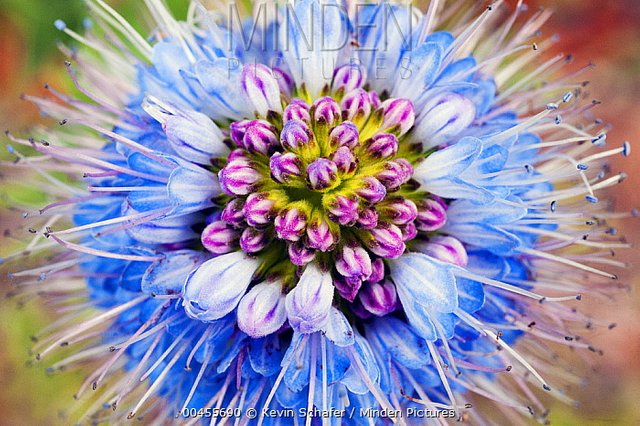
http://www.malibutimes.com/blogs/article_36f0ce20-b5aa-11e2-a100-0019bb2963f4.html
Downvoting a post can decrease pending rewards and make it less visible. Common reasons:
Submit
magoo-2 found a series of multi accounts of a same owner is following your articles to cheat your generous rewards.
magoo-2 found these accounts are suspicious & can be multi accounts of a single owner. Conclusion is based on last 1 year transactions:
@jacqueline5
@african1
@merina
@marizanne
@miller1
@jerry1994
@aarshi
@nawmi
@maisha
@jenifer2
@masud1
@jerry2
@selina2
@bingham
@mulder2000
@umess
@neerose123
@diaa07
magoo-2
Check our latest multi comment spam update report
Downvoting a post can decrease pending rewards and make it less visible. Common reasons:
Submit
his plant is absolutely gorgeous! Need I say more? The picture above summarizes it nicely. Most people are more familiar with Echium wilpretti which has red flowers. These are striking, but grow larger and don't tend to branch into the attractive plant that the blue species does.
As the name suggests, this plant is native to the island of Madeira. This is owned by Portugal and located off the coast of Morocco. It's tolerant of coastal exposure and salt spray but requires well drained soil. These Echium typically reach a height of 2m and bloom in the spring. They can take freezing temperatures and are considered hardy to USDA zone 9a.

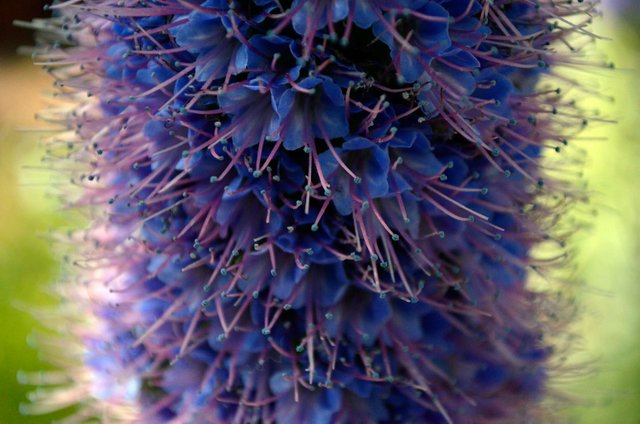
Seeds germinate readily and most should have sprouted within 2 weeks. They should be sown in a well drained potting mix, about 1/2cm deep and at room temperature. Plants establish themselves the first year and then reward you with flowers thereafter. If stressed they may only last two years but are generally considered a perennial.
http://plant-zone.blogspot.com/2011/10/germinating-pride-of-madeira-echium.html
Downvoting a post can decrease pending rewards and make it less visible. Common reasons:
Submit
magoo-2 found a series of multi accounts of a same owner is following your articles to cheat your generous rewards.
magoo-2 found these accounts are suspicious & can be multi accounts of a single owner. Conclusion is based on last 1 year transactions:
@jacqueline5
@african1
@merina
@marizanne
@miller1
@jerry1994
@aarshi
@nawmi
@maisha
@jenifer2
@masud1
@jerry2
@selina2
@bingham
@mulder2000
@umess
@neerose123
@diaa07
magoo-2
Check our latest multi comment spam update report
Downvoting a post can decrease pending rewards and make it less visible. Common reasons:
Submit
Beautiful plant . Flowers colors and it's height are just amazing.. this plant looks different in many plants . Very suitable name "Pride of Madiera'
Downvoting a post can decrease pending rewards and make it less visible. Common reasons:
Submit
Brilliant plant. A standout amongst the most uncommon plants I have ever observed.
Downvoting a post can decrease pending rewards and make it less visible. Common reasons:
Submit
On our last visit to the Gamble Garden in Palo Alto, we came across an impressive cluster of thick stems (clearly some years old) standing about 3 feet tall, with conical clusters of buds at the top of the stems. The only label we could find was for an obviously irrelevant plant (a daisy-like composite).
But then this morning we went back, and it was in gorgeous purple-blue bloom. Back home, I thought to try a strategy that almost never works in Google searches: describing the plant (“tall spires of purple flowers”), but this time I hit paydirt right away, with a page devoted to plants with tall stalks of purple/blue flowers.
https://arnoldzwicky.org/2017/03/28/pride-of-madeira/
Downvoting a post can decrease pending rewards and make it less visible. Common reasons:
Submit
magoo-2 found a series of multi accounts of a same owner is following your articles to cheat your generous rewards.
magoo-2 found these accounts are suspicious & can be multi accounts of a single owner. Conclusion is based on last 1 year transactions:
@jacqueline5
@african1
@merina
@marizanne
@miller1
@jerry1994
@aarshi
@nawmi
@maisha
@jenifer2
@masud1
@jerry2
@selina2
@bingham
@mulder2000
@umess
@neerose123
@diaa07
magoo-2
Check our latest multi comment spam update report
Downvoting a post can decrease pending rewards and make it less visible. Common reasons:
Submit
Beautiful plant for home garden . Flowers are amazing . This plant is pride of garden. I am first time seeing this paint . Thanks for blog
Downvoting a post can decrease pending rewards and make it less visible. Common reasons:
Submit
Pride of Madeira (Echium candicans) makes a bold statement in perennial gardens with its 6- to 8-foot-tall flower stalks, which are smothered in small, brilliant purple flowers. It thrives in coastal areas and mild inland valleys within U.S. Department of Agriculture plant hardiness zones 9 and 10, where it is widely grown as an ornamental. Pride of Madeira propagates reliably from fresh seeds, which will germinate without stratification. The seeds can be planted indoors in autumn or eight weeks before the last frost for transplant in spring after the soil has warmed and all frost danger has passed.
source
Downvoting a post can decrease pending rewards and make it less visible. Common reasons:
Submit
magoo-2 found a series of multi accounts of a same owner is following your articles to cheat your generous rewards.
magoo-2 found these accounts are suspicious & can be multi accounts of a single owner. Conclusion is based on last 30 days transactions:
@astique
@alinaloredana
@archista
magoo-2
Check our latest multi comment spam update report
Downvoting a post can decrease pending rewards and make it less visible. Common reasons:
Submit
Other common names
pride of Madeira
Family
Boraginaceae
Genus
Echium can be annuals, biennials, evergreen perennials or shrubs, with simple, coarsely hairy leaves and funnel-shaped flowers borne in panicles or dense spikes in summer
Details
E. candicans is a bushy biennial sub-shrub with grey-hairy lance-shaped leaves and dense terminal spike-like panicles of white, pale or deep blue flowers in spring and summer
Plant range
Madeira
source
Downvoting a post can decrease pending rewards and make it less visible. Common reasons:
Submit
magoo-2 found a series of multi accounts of a same owner is following your articles to cheat your generous rewards.
magoo-2 found these accounts are suspicious & can be multi accounts of a single owner. Conclusion is based on last 1 year transactions:
@kheightces
@thytheso
@mabir
@ristotle
@tanuesh
@alizamanjutt454
@eastmund
@vijayar
@lycusa
@snorio
@alexeyy
@surenda
@isuru1127
magoo-2
Check our latest multi comment spam update report
Downvoting a post can decrease pending rewards and make it less visible. Common reasons:
Submit
Another plant whose flowers exactly repeat the plant that grows in our meadows. It is poisonous and it is from Australia. I think that this is the same plant, but it has changed the shape of the leaves and the candle inflorescence.
We call this plant a bruise or Échium. It is poisonous, but is an excellent honey plant. Bees adore him.
Look, the flowers are the same, so it seems to me.
Thank! Have a great day!
Downvoting a post can decrease pending rewards and make it less visible. Common reasons:
Submit
It may grow here, but it is not an Australian native plant :)
Downvoting a post can decrease pending rewards and make it less visible. Common reasons:
Submit
Homeland of this plant is Australia. You can easily check this in wikipedia.
Downvoting a post can decrease pending rewards and make it less visible. Common reasons:
Submit
Talk:Echium
Echium fatuosum
I see Echium fatuosum referred to in various places, and it's not at all clear to me if this is a synonym for Echium candicans or not. E.g. see [1]. Either way it would be good to clear this up in the article.
According to IPNI, four different authors described an Echium fastuosum, so which one are you referring to? MattBuys (talk)
Miscellaneous
Add further questions
No Context
Sorry about the no context tag. I totally spaced on that one. I was looking at this talk page when I thought I was looking at the article. Doh! Thanks for fixing it for me.
Rattlesnake soap from Mexico
Found a product made in Mexico, called Jabon de Aceite de vivora de cascabel, or rattlesnake soap. i believe it is a castile soap (or maybe a glycerin soap) made from a variety of Echium, possibly using oil from that plant, and the soda ash from this plant. the soap claims to be lye free, which may be disingenuous. "none alkaloide none acid" made out of minerals and herbs. if left on a wet surface it will go soft and melt away. If this is a traditional soap made in la Reyna de Monterrey, NL, it probably deserves a mention somewhare on english or spanich WP if we can find references.
https://en.wikipedia.org/wiki/Talk%3AEchium
Downvoting a post can decrease pending rewards and make it less visible. Common reasons:
Submit
magoo-2 found a series of multi accounts of a same owner is following your articles to cheat your generous rewards.
magoo-2 found these accounts are suspicious & can be multi accounts of a single owner. Conclusion is based on last 30 days transactions:
@dtube2
@masud1234
magoo-2
Check our latest multi comment spam update report
Downvoting a post can decrease pending rewards and make it less visible. Common reasons:
Submit
A migrant from the Portuguese island of Madeira off the coast of NW Africa, once a specimen establishes itself, the plant can withstand xeric (drought-like) conditions, blasting winds and sustained periods of rain. Most of the ones I see around the Bay Area grew naturally, though they make a superb addition to any sizable yard. If you live around here and haven’t paid much notice before you’ll see them all over the place. They are in bloom for another month but I believe they’ve already hit their peak for the year. Take time when checking out their massive bloom cone as also highly appreciated by hummingbirds and butterflies.
The Pride of Madeira is the common name for a spectacular looking shrub in the Echium genus of plants, many species of which are known as types of Viper’s Bugloss or “Taginaste” in Spain. Known to botanists as Echium candicans, the Pride of Madeira comes, as its name suggests, from Madeira, but it is often grown in gardens and parks throughout Iberia and in many other parts of the world. Its popularity is hardly surprising because it forms a very large bush that is covered in spring and early summer in magnificent flowering spikes of purplish-blue flowers with red stamens. The Pride of Madeira will definitely catch your eye and is very attractive to bees and other pollinating insects too, as are the other species in the Echium genus.
http://bardofelysays.blogspot.com/2018/05/the-pride-of-madeira.html
Downvoting a post can decrease pending rewards and make it less visible. Common reasons:
Submit
Wow,this is nice garden.
And photography is outstanding.
Thank you for your valuable post.
Downvoting a post can decrease pending rewards and make it less visible. Common reasons:
Submit
Echium fastuosum
'Star of Madeira'
Absolutely fabulous focality! It’s rare that I fall in love with a variegated plant (sorry, guys – I instinctively want to mother them back to full “healthy” greenness) but this stunningly variegated form of “Pride of Madeira” is so lush, vigorous & dense of habit – to 4’ tall & 7’ across – even out of bloom, it makes a terrific light-up-the-garden focal shrub. Of course, there are also those big, fat blue spikes held well above the foliage in Spring. Really, who wouldn’t want this dramatic & carefree shrub in their garden? Highly drought tolerant, but I’d give it at least some occasional Summer water & tip prune for ultimate best appearance. Not fussy about soil, but does appreciate good drainage, so it’s an excellent choice for low water hillsides. Likes a bit of annual compost, too. Attracts bees, hummers & butterflies. Self sows.
https://www.anniesannuals.com/plants/view/?id=4046
Downvoting a post can decrease pending rewards and make it less visible. Common reasons:
Submit
magoo-2 found a series of multi accounts of a same owner is following your articles to cheat your generous rewards.
magoo-2 found these accounts are suspicious & can be multi accounts of a single owner. Conclusion is based on last 1 year transactions:
@sony1992
@melissa1999
@max1994
@tania12
@lararose
magoo-2
Check our latest multi comment spam update report
Downvoting a post can decrease pending rewards and make it less visible. Common reasons:
Submit
I recently rediscovered a book in my personal library called, “The Flowers and Gardens of Madeira” (publishers Adam and Charles Black, 1909), illustrated and written by Ella and Florence Du-Cane. The book evokes a genteel moment in time when a pair of traveling women might have found a freedom of expression in the writings and artistic considerations of private, walled, and public gardens. Ella’s pen, ink and watercolor paintings are charming studies of flowers in-situ: fountains, pathways, terraces and cliff sights, all stunning in detail, color and composition. Along with Florence’s in depth descriptions and historic references, the Du-Canes fulfill an image of a one time Mediterranean paradise, and a more romantic era.
Now an antique, the illustrations and colorful narrative in “The Flowers and Gardens of Madeira” brings to minds eye the end of the "Gilded Age," and perhaps a scene executed by the master watercolorist himself John Singer Sargeant. The painting would feature the sisters Du-Cane in ankle length dresses under parasols, one with a sketchpad, the other taking notes. At the plaza water fountain, arm in arm on a cobbled road, or perhaps sharing tea with Edith Wharton and Henry James in the shade of a villa garden by a wall dripping in Bougainvillea spectabile, with its brick-red blossoms.
http://www.malibutimes.com/blogs/article_36f0ce20-b5aa-11e2-a100-0019bb2963f4.html
Downvoting a post can decrease pending rewards and make it less visible. Common reasons:
Submit
magoo-2 found a series of multi accounts of a same owner is following your articles to cheat your generous rewards.
magoo-2 found these accounts are suspicious & can be multi accounts of a single owner. Conclusion is based on last 1 year transactions:
@jacqueline5
@african1
@merina
@marizanne
@miller1
@jerry1994
@aarshi
@nawmi
@maisha
@jenifer2
@masud1
@jerry2
@selina2
@bingham
@mulder2000
@umess
@neerose123
@diaa07
@rayhankhan
magoo-2
Check our latest multi comment spam update report
Downvoting a post can decrease pending rewards and make it less visible. Common reasons:
Submit
First and foremost is the perennial shrub called pride of Madeira, Echium candicans or Echium fastuosum, which sports gorgeous cone-shaped flower spikes this time of year. You’ll see these plants blooming profusely from now through May.
Their flower spikes, each of which contains thousands of individual blossoms, attract butterflies, bees and hummingbirds in droves. You’ll see them not only in blue, but in many shades of purple and lavender, as well as a dusty pink.
The only caveat with pride of Madeira is that the plants tend to get very large very fast. They can easily grow 10 feet tall and 10 feet wide within two to three years. Experts recommend pruning or pinching back once or twice during the year to maintain shape and keep the plant from getting lanky.
https://leisureguy.wordpress.com/2010/03/20/pride-of-madeira/
Downvoting a post can decrease pending rewards and make it less visible. Common reasons:
Submit
WHAT MAKES Pride of Madeira SPECIAL

Pride of Madeira is also known as the Tower of Jewels, which is fitting, as it grows in tall, cone-shaped spikes that boast thousands of indigo and magenta flowers that attract bees, butterflies and hummingbirds.
In California, Pride of Madeira is sometimes considered an invasive species, which means that it overgrows and sort of takes over the area.
Some of my favorite plants are considered invasive - I’m sure there are some plant folks in California wouldn’t be happy about this, but I wouldn’t mind if Pride of Madeira took over. They’re just so interesting-looking, and fun! And they support us in their own magical way.
Pride of Madeira is also perfect for gardeners that don’t have green thumbs. It grows in poor soil and is drought tolerant - it actually doesn’t like too much water. It tolerates wind and salty air from the ocean, making it a good coastal plant.
Pride of Madeira is beautiful to look at and be around, but not to touch or eat. The plant has all kinds of little hairs on it, which are irritating to the skin and the plant is actually poisonous - all parts of the plant are inedible.
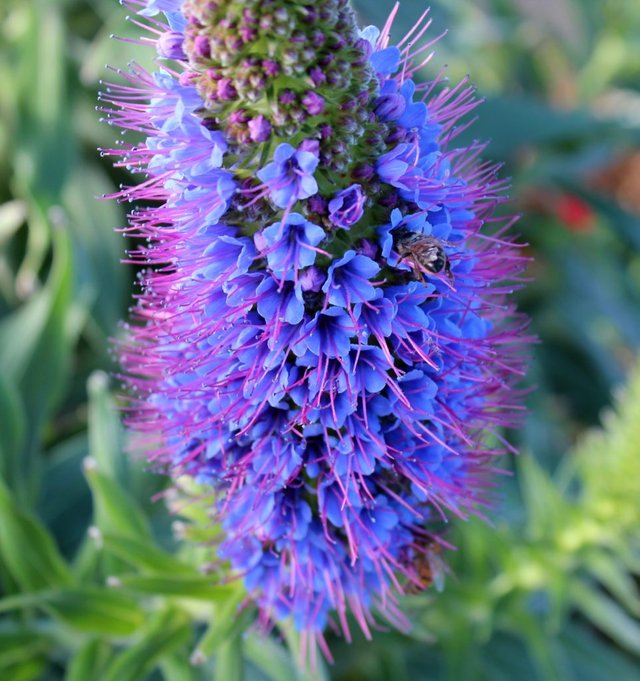
The beauty of using flower essences is that you can get the benefits of flowers that are poisonous. The remedies are so dilute, that there is no longer any plant parts or chemistry left in the liquid, only the energetic imprint of the flower. It’s similar to homeopathy: when you take the poisonous Belladona or Arsenic in homeopathic form, it’s healing for the body and soothing for the mind.
The Pride of Madeira is all about feeling beautiful, exotic and exquisite - helping you perceive and embody that you’re in the right place at the right time. All of those things about you that make you different, that in the past may have made you feel awkward or out of place, become what makes you exotic and sexy.
https://www.lotuswei.com/blogs/blog/flowers-pride-of-madeira-flower-essence
Downvoting a post can decrease pending rewards and make it less visible. Common reasons:
Submit
{PRIDE OF MADEIRA} MAGIC. FULL EXPRESSION. SELF-ACCEPTANCE.

Pride of Madeira is native to the Canary Islands and Madeira, an island off the coast of Portugal.
I went to the Canary Islands when I was 21 years old and living in Madrid, Spain. We had a long holiday break from the University in December, and a friend invited me to his house on the small volcanic island of La Palma. What a magical place!
Everything about the La Palma is exotic, unique and breathtaking, and it is from here in the Canary Islands, as well as the island of Madeira, where the Pride of Madeira flower originally comes from.
Ironically, I didn’t collect this flower essence on the island - I collected it north of San Francisco, years later. I discovered it in the Bay area one spring and fell totally in love all over again. It grows in tall cones along the roads in massive towers of blue and purple that almost have a human quality. It has that exquisite magical quality that the Canary Islands had - it makes absolute sense that it’s native to such fantasy-like islands.>
https://www.lotuswei.com/blogs/blog/flowers-pride-of-madeira-flower-essence
Downvoting a post can decrease pending rewards and make it less visible. Common reasons:
Submit
The Canary Islands are home to very many endemic types of Echium and the Mt Teide Bugloss or Red Bugloss (E. wildpretti) is a plant symbolic of Tenerife where it grows high on the mountain it is named after. This unusual plant is a biennial that produces a large rosette of leaves in its first year which is followed by a tall flowering spike in its second year. The tiny flowers are a pinkish-red but there are many thousands of them and its flower spikes can grow to as much as three metres in height. They stand out like weird red wands above the otherworldly and barren terrain on Mt Teide, which is the highest mountain, not only in Tenerife but in all of Spain.
The Red Bugloss is a very rare plant in the wild, and only found on Mt Teide and around the village of Vilaflor which is also high in the Tenerife mountains. The plant has evolved to be adapted to the cold nights and bright sunlight by day of the habitats it is found in, though it is also grown at lower levels of the island in parks and gardens. Because of its tall flowering spikes it is one of the bugloss species often called “Tower of Jewels.
http://bardofelysays.blogspot.com/2018/05/the-pride-of-madeira.html
Downvoting a post can decrease pending rewards and make it less visible. Common reasons:
Submit
Ironically, I didn’t collect this flower essence on the island - I collected it north of San Francisco, years later. I discovered it in the Bay area one spring and fell totally in love all over again. It grows in tall cones along the roads in massive towers of blue and purple that almost have a human quality. It has that exquisite magical quality that the Canary Islands had - it makes absolute sense that it’s native to such fantasy-like islands.>
Pride of Madeira reseeds freely and so it’s easy to get babies if you have a friend with mature plants. Plants also can be started from cuttings. They’ll require occasional water during the first summer in order to get established, but after that need little or no care.
https://leisureguy.wordpress.com/2010/03/20/pride-of-madeira/
Downvoting a post can decrease pending rewards and make it less visible. Common reasons:
Submit
magoo-2 found a series of multi accounts of a same owner is following your articles to cheat your generous rewards.
magoo-2 found these accounts are suspicious & can be multi accounts of a single owner. Conclusion is based on last 1 year transactions:
@jacqueline5
@african1
@merina
@marizanne
@miller1
@jerry1994
@aarshi
@nawmi
@maisha
@jenifer2
@masud1
@jerry2
@selina2
@bingham
@mulder2000
@umess
@neerose123
@diaa07
magoo-2
Check our latest multi comment spam update report
Downvoting a post can decrease pending rewards and make it less visible. Common reasons:
Submit
The deliriously blue-purple conical shaped flowers you see shimmering along our arid coastline every spring is the Pride of Madeira. I like to call it the Pride of Malibu. Its botanical name is Echium Candicans which sounds like “eating candy” to me. Don’t try to eat it. From a distance this biennial subshrub looks fuzzy and soft, but in fact it is quite a defensive plant with taut spikes that jut outward from the cob at its core. Look closely, and imagine as I do a Chopard bracelet made up of rows and rows of saphire and amethyst florets. Nature’s jewels. And attract, it does.
I leave this borage to the butterflies and bees to contently hum and flutter about the bright dome heads when in bloom. Let them eat cake! So beautiful are these freaky flowers, you might want to handle their “clusters.” Warning! Do not touch without gloves, lest nature’s beauty will bite back causing serious skin chafing and allergic reactions.
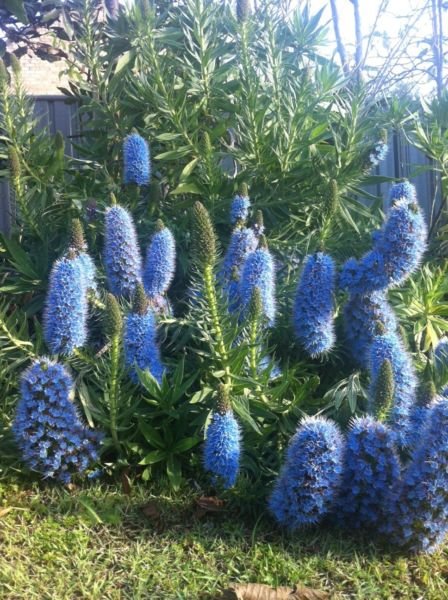
At the instant I photographed this Pride of Madeira with my iPhone, its beacon of color filled me with the anticipation of spring. Even now I marvel at the way the light upon the flower creates an illusion that light radiates from its interior.
The Pride of Madeira is a native plant that originates from an island of the same name off the coast of Portugal, near Morocco. Madeira means wood in Spanish, which makes sense since the island once had vast forests.
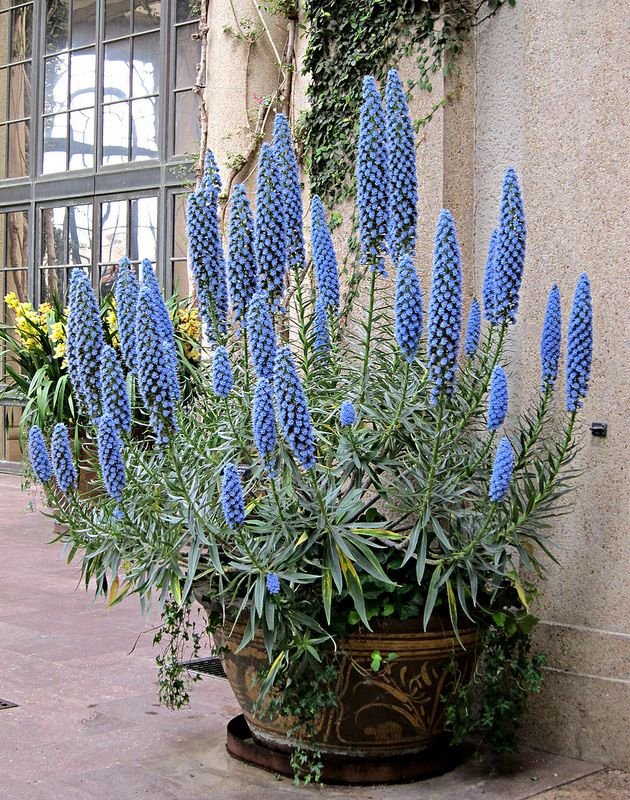
http://www.malibutimes.com/blogs/article_36f0ce20-b5aa-11e2-a100-0019bb2963f4.html
Downvoting a post can decrease pending rewards and make it less visible. Common reasons:
Submit
magoo-2 found a series of multi accounts of a same owner is following your articles to cheat your generous rewards.
magoo-2 found these accounts are suspicious & can be multi accounts of a single owner. Conclusion is based on last 1 year transactions:
@jacqueline5
@african1
@merina
@marizanne
@miller1
@jerry1994
@aarshi
@nawmi
@maisha
@jenifer2
@masud1
@jerry2
@selina2
@bingham
@mulder2000
@umess
@neerose123
@diaa07
magoo-2
Check our latest multi comment spam update report
Downvoting a post can decrease pending rewards and make it less visible. Common reasons:
Submit
We love that this old classic is coming back in popular demand. The Pride of Madeira is an excellent prolific flowering plant with gorgeous and tall purple flowers.
If you’re looking for a low maintenance flowering plant with maximum impact, this plant might be just what you’re after. It’s a perennial and grows excellently in Australian coastal areas, requiring minimal watering and care.
Reaching a maximum of about 3 metres tall and 2 meters wide, the Echium Candicans grows best in full sun. Soil should be well drained and not too rich or moist. For care, once flowering has finished prune off the flower spikes. This will encourage growth of more branches for next season!
We like the idea of making a bold colour and size statement with this plant. Once you see this plant in all it’s glory, well placed in any garden setting, it is hard to forget. We recommend planting the Pride of Madeira in an area which allows plenty of space for it to grow. We would also advise planting it at the back of your garden beds so it doesn’t over shade other plants.
http://www.adamrobinsondesign.com/blog-posts/plant-of-the-month-pride-of-madeira
Downvoting a post can decrease pending rewards and make it less visible. Common reasons:
Submit
magoo-2 found a series of multi accounts of a same owner is following your articles to cheat your generous rewards.
magoo-2 found these accounts are suspicious & can be multi accounts of a single owner. Conclusion is based on last 1 year transactions:
@jacqueline5
@african1
@merina
@marizanne
@miller1
@jerry1994
@aarshi
@nawmi
@maisha
@jenifer2
@masud1
@jerry2
@selina2
@bingham
@mulder2000
@umess
@neerose123
@diaa07
@rayhankhan
magoo-2
Check our latest multi comment spam update report
Downvoting a post can decrease pending rewards and make it less visible. Common reasons:
Submit
https://media.gettyimages.com/photos/echium-candicans-commonly-known-as-pride-of-madeira-a-species-of-in-picture-id953300576?k=6&m=953300576&s=612x612&w=0&h=-QeATo6N9KtizV_EWhsWy322z4Ocappux1SG0c9syzU=
Pride of Madeira its an agency that always makes the clients a priority since we are part of their holiday to make it as memorable as possible! We might be a small agency but we have so much to give and show! So if you are looking to book some tours and walks to get to know the island, look no more we are your choice!!! Welcome to Madeira,
The beauty of using flower essences is that you can get the benefits of flowers that are poisonous. The remedies are so dilute, that there is no longer any plant parts or chemistry left in the liquid, only the energetic imprint of the flower. It’s similar to homeopathy: when you take the poisonous Belladona or Arsenic in homeopathic form, it’s healing for the body and soothing for the mind.
https://www.lotuswei.com/blogs/blog/flowers-pride-of-madeira-flower-essence
Downvoting a post can decrease pending rewards and make it less visible. Common reasons:
Submit
magoo-2 found a series of multi accounts of a same owner is following your articles to cheat your generous rewards.
magoo-2 found these accounts are suspicious & can be multi accounts of a single owner. Conclusion is based on last 1 year transactions:
@jacqueline5
@african1
@merina
@marizanne
@miller1
@jerry1994
@aarshi
@nawmi
@maisha
@jenifer2
@masud1
@jerry2
@selina2
@bingham
@mulder2000
@umess
@neerose123
@diaa07
@rayhankhan
magoo-2
Check our latest multi comment spam update report
Downvoting a post can decrease pending rewards and make it less visible. Common reasons:
Submit
Their flower spikes, each of which contains thousands of individual blossoms, attract butterflies, bees and hummingbirds in droves. You’ll see them not only in blue, but in many shades of purple and lavender, as well as a dusty pink.
Downvoting a post can decrease pending rewards and make it less visible. Common reasons:
Submit
magoo-2 found a series of multi accounts of a same owner is following your articles to cheat your generous rewards.
magoo-2 found these accounts are suspicious & can be multi accounts of a single owner. Conclusion is based on last 30 days transactions:
@itamarr
@chocosteem
@berwyn
@benedetto
@bronter
@hungduan
magoo-2
Check our latest multi comment spam update report
Downvoting a post can decrease pending rewards and make it less visible. Common reasons:
Submit
First and foremost is the perennial shrub called pride of Madeira, Echium candicans or Echium fastuosum, which sports gorgeous cone-shaped flower spikes this time of year. You’ll see these plants blooming profusely from now through May.
source
Downvoting a post can decrease pending rewards and make it less visible. Common reasons:
Submit
magoo-2 found a series of multi accounts of a same owner is following your articles to cheat your generous rewards.
magoo-2 found these accounts are suspicious & can be multi accounts of a single owner. Conclusion is based on last 30 days transactions:
@itamarr
@chocosteem
@berwyn
@benedetto
@bronter
@hungduan
magoo-2
Check our latest multi comment spam update report
Downvoting a post can decrease pending rewards and make it less visible. Common reasons:
Submit
Echium fastuosum, or Echium candicans, is also known as pride of Madeira, being native to Madeira and is part of the Boraginaceae family. Echium fastuosum is big, bold and beautiful. This half-hardy biennial is a showy, evergreen, perennial plant that can reach up to 5 - 8 ft tall and 6-10 feet wide. It is a large picturesque plant with coarse heavy branches and an excellent foliage plant. Spike like clusters of bluish purple flowers standout above the foliage in the spring. Use Echium against walls and at the back of flower borders or on slopes for a dramatic effect.
source
Downvoting a post can decrease pending rewards and make it less visible. Common reasons:
Submit
magoo-2 found a series of multi accounts of a same owner is following your articles to cheat your generous rewards.
magoo-2 found these accounts are suspicious & can be multi accounts of a single owner. Conclusion is based on last 30 days transactions:
@itamarr
@chocosteem
@berwyn
@benedetto
@bronter
@hungduan
magoo-2
Check our latest multi comment spam update report
Downvoting a post can decrease pending rewards and make it less visible. Common reasons:
Submit
pride of Madeira does best when left alone, preferably in poor soil and with little water — a lazy gardener’s dream. Rich soil and too much moisture are actually detrimental to the plant and can kill it. Some sources say it doesn’t do well in clay soil, and too much shade will keep the plant from blooming.
Pride of Madeira reseeds freely and so it’s easy to get babies if you have a friend with mature plants. Plants also can be started from cuttings. They’ll require occasional water during the first summer in order to get established, but after that need little or no care.
The only caveat with pride of Madeira is that the plants tend to get very large very fast. They can easily grow 10 feet tall and 10 feet wide within two to three years. Experts recommend pruning or pinching back once or twice during the year to maintain shape and keep the plant from getting lanky.
Downvoting a post can decrease pending rewards and make it less visible. Common reasons:
Submit
magoo-2 found a series of multi accounts of a same owner is following your articles to cheat your generous rewards.
magoo-2 found these accounts are suspicious & can be multi accounts of a single owner. Conclusion is based on last 1 year transactions:
@jacqueline5
@african1
@merina
@marizanne
@miller1
@jerry1994
@aarshi
@nawmi
@maisha
@jenifer2
@masud1
@jerry2
@selina2
@bingham
@mulder2000
@umess
@neerose123
@diaa07
magoo-2
Check our latest multi comment spam update report
Downvoting a post can decrease pending rewards and make it less visible. Common reasons:
Submit
First and foremost is the perennial shrub called pride of Madeira, Echium candicans or Echium fastuosum, which sports gorgeous cone-shaped flower spikes this time of year. You’ll see these plants blooming profusely from now through May.
Their flower spikes, each of which contains thousands of individual blossoms, attract butterflies, bees and hummingbirds in droves. You’ll see them not only in blue, but in many shades of purple and lavender, as well as a dusty pink.
Pride of Madeira, which can be found in gardens and along roadsides all over the Central Coast, is native to Portugal’s Madeira Island. Because it flourishes in Mediterranean climates and likes dry conditions, it is perfectly suited to our part of California.
In fact, pride of Madeira does best when left alone, preferably in poor soil and with little water — a lazy gardener’s dream. Rich soil and too much moisture are actually detrimental to the plant and can kill it. Some sources say it doesn’t do well in clay soil, and too much shade will keep the plant from blooming.
https://leisureguy.wordpress.com/2010/03/20/pride-of-madeira/
Downvoting a post can decrease pending rewards and make it less visible. Common reasons:
Submit
magoo-2 found a series of multi accounts of a same owner is following your articles to cheat your generous rewards.
magoo-2 found these accounts are suspicious & can be multi accounts of a single owner. Conclusion is based on last 1 year transactions:
@jacqueline5
@african1
@merina
@marizanne
@miller1
@jerry1994
@aarshi
@nawmi
@maisha
@jenifer2
@masud1
@jerry2
@selina2
@bingham
@mulder2000
@umess
@neerose123
@diaa07
magoo-2
Check our latest multi comment spam update report
Downvoting a post can decrease pending rewards and make it less visible. Common reasons:
Submit
Pride of Madeira (Echium candicans) makes a bold statement in perennial gardens with its 6- to 8-foot-tall flower stalks, which are smothered in small, brilliant purple flowers. It thrives in coastal areas and mild inland valleys within U.S. Department of Agriculture plant hardiness zones 9 and 10, where it is widely grown as an ornamental.
source
Downvoting a post can decrease pending rewards and make it less visible. Common reasons:
Submit
magoo-2 found a series of multi accounts of a same owner is following your articles to cheat your generous rewards.
magoo-2 found these accounts are suspicious & can be multi accounts of a single owner. Conclusion is based on last 30 days transactions:
@itamarr
@chocosteem
@berwyn
@benedetto
@bronter
@hungduan
magoo-2
Check our latest multi comment spam update report
Downvoting a post can decrease pending rewards and make it less visible. Common reasons:
Submit
Echium candicans
Connected to: Madeira Data Deficient Boraginaceae
Pride of Madeira
Conservation status
Data Deficient (IUCN 3.1)[1]


Scientific classification edit
Kingdom: Plantae
Clade: Angiosperms
Clade: Eudicots
Clade: Asterids
Order: Boraginales
Family: Boraginaceae
Genus: Echium
Species: E. candicans
Binomial name
Echium candicans.
Downvoting a post can decrease pending rewards and make it less visible. Common reasons:
Submit
Magoo-2 found a series of multi accounts of a same owner is following your articles to cheat your generous rewards.
Magoo-2 found these accounts are suspicious & can be multi accounts of a single owner. Conclusion is based on last 30 days transactions:
@abdt
@wolf-kinght
@sardar-sani
magoo-2
Check our latest multi comment spam update report
Downvoting a post can decrease pending rewards and make it less visible. Common reasons:
Submit
To describe Pride of Madeira's features as anything other than stunning doesn’t do the plant justice. You’ve probably heard the list of attributes before — purple flower spikes, mounding habit, low water use, coastal tolerant, sage green foliage — but once you've seen a Pride of Madeira and all its charms, you’ll never forget it. Like the island it hails from, Pride of Madeira allures from both near and far.
source
Downvoting a post can decrease pending rewards and make it less visible. Common reasons:
Submit
magoo-2 found a series of multi accounts of a same owner is following your articles to cheat your generous rewards.
magoo-2 found these accounts are suspicious & can be multi accounts of a single owner. Conclusion is based on last 1 year transactions:
@kheightces
@thytheso
@mabir
@ristotle
@tanuesh
@alizamanjutt454
@eastmund
@vijayar
@lycusa
@snorio
@alexeyy
@surenda
@isuru1127
magoo-2
Check our latest multi comment spam update report
Downvoting a post can decrease pending rewards and make it less visible. Common reasons:
Submit
Echium candicans (syn. Echium fastuosum J.Jacq.[3]), commonly known as pride of Madeira, is a species of flowering plant in the family Boraginaceae, native to the island of Madeira. It is a large herbaceous Perennial subshrub, growing to 1.5–2.5 m (4 ft 11 in–8 ft 2 in).
In the first year after germination the plant produces a broad rosette of leaves. In the second and subsequent years more or less woody flowering stalks are produced clothed in rough leaves. The flower head is large and covered with white or blue flowers having red stamens. It is much visited by bees and butterflies for its nectar.
Echium candicans is cultivated in the horticulture trade and widely available throughout the world as an ornamental plant for traditional and drought tolerant water conserving gardens. It is particularly suitable for coastal planting, and is a popular ornamental in coastal California. With a minimum temperature requirement of 5–7 °C (41–45 °F), in frost-prone areas it needs some winter protection. It has gained the Royal Horticultural Society's Award of Garden Merit.
source
Downvoting a post can decrease pending rewards and make it less visible. Common reasons:
Submit
magoo-2 found a series of multi accounts of a same owner is following your articles to cheat your generous rewards.
magoo-2 found these accounts are suspicious & can be multi accounts of a single owner. Conclusion is based on last 1 year transactions:
@kheightces
@thytheso
@mabir
@ristotle
@tanuesh
@alizamanjutt454
@eastmund
@vijayar
@lycusa
@snorio
@alexeyy
@surenda
@isuru1127
magoo-2
Check our latest multi comment spam update report
Downvoting a post can decrease pending rewards and make it less visible. Common reasons:
Submit
Echium fastuosum
Botanical Name: Echium fastuosum
Common Name(s): Pride of Madeira
Categories: Shrubs and Perennials
Description:
Free-flowering shrub with spikes of deep blue flowers in summer. This fast-growing, grey-leaved plant is excellent for dry areas. It is rather shortlived but self-seeds easily.
Family: –
Synonym: –
Botanical Pronunciation: EK-ee-um fas-tew-OH-sum
http://plantinfo.co.za/plant/echium-fastuosum/
Downvoting a post can decrease pending rewards and make it less visible. Common reasons:
Submit
magoo-2 found a series of multi accounts of a same owner is following your articles to cheat your generous rewards.
magoo-2 found these accounts are suspicious & can be multi accounts of a single owner. Conclusion is based on last 1 year transactions:
@sony1992
@melissa1999
@max1994
@tania12
@lararose
magoo-2
Check our latest multi comment spam update report
Downvoting a post can decrease pending rewards and make it less visible. Common reasons:
Submit
The plant is awesome it looks great thanks for introducing yet another amazing research thanks a lot for sharing.
Downvoting a post can decrease pending rewards and make it less visible. Common reasons:
Submit
magoo-2 found a series of multi accounts of a same owner is following your articles to cheat your generous rewards.
magoo-2 found these accounts are suspicious & can be multi accounts of a single owner. Conclusion is based on last 30 days transactions:
@itamarr
@chocosteem
@berwyn
@benedetto
@bronter
@hungduan
magoo-2
Check our latest multi comment spam update report
Downvoting a post can decrease pending rewards and make it less visible. Common reasons:
Submit
A fast growing, coastal perennial shrub with spectacular 60cm long, violet blue flower spires, blooming in winter and spring. This frost hardy, evergreen species needs a sunny position with well drained, ordinary soil and a Mediterranean climate. Drought and salt tolerant. Good for embankments.
source
Downvoting a post can decrease pending rewards and make it less visible. Common reasons:
Submit
magoo-2 found a series of multi accounts of a same owner is following your articles to cheat your generous rewards.
magoo-2 found these accounts are suspicious & can be multi accounts of a single owner. Conclusion is based on last 1 year transactions:
@saikr
@christian.danny
@aaeesha
@sarah.taylor
magoo-2
Check our latest multi comment spam update report
Downvoting a post can decrease pending rewards and make it less visible. Common reasons:
Submit
This is very amazing plant . Both colors are pretty. It has tall and unique type flowers which gives it a different look. Good plant
Downvoting a post can decrease pending rewards and make it less visible. Common reasons:
Submit
magoo-2 found a series of multi accounts of a same owner is following your articles to cheat your generous rewards.
magoo-2 found these accounts are suspicious & can be multi accounts of a single owner. Conclusion is based on last 1 year transactions:
@pardeepkumar
@sami100
magoo-2
Check our latest multi comment spam update report
Downvoting a post can decrease pending rewards and make it less visible. Common reasons:
Submit
My parents village have similar, but in green color. Children use to play with them since they stick to clothes
Posted using Partiko Android
Downvoting a post can decrease pending rewards and make it less visible. Common reasons:
Submit
magoo-2 found a series of multi accounts of a same owner is following your articles to cheat your generous rewards.
magoo-2 found these accounts are suspicious & can be multi accounts of a single owner. Conclusion is based on last 30 days transactions:
@desikaamukkahani
@nkleet
magoo-2
Check our latest multi comment spam update report
Downvoting a post can decrease pending rewards and make it less visible. Common reasons:
Submit
You bloody blind bitch. Nkleet is not following him. Neither i know him
Posted using Partiko Android
Downvoting a post can decrease pending rewards and make it less visible. Common reasons:
Submit
Nice flowers selection. I love echium flowers.
Downvoting a post can decrease pending rewards and make it less visible. Common reasons:
Submit
magoo-2 found a series of multi accounts of a same owner is following your articles to cheat your generous rewards.
magoo-2 found these accounts are suspicious & can be multi accounts of a single owner. Conclusion is based on last 1 year transactions:
@sony1992
@melissa1999
@max1994
@tania12
@lararose
magoo-2
Check our latest multi comment spam update report
Downvoting a post can decrease pending rewards and make it less visible. Common reasons:
Submit
Excellent photography my dear friend and this plant not available my country.
Downvoting a post can decrease pending rewards and make it less visible. Common reasons:
Submit
Foliage - Evergreen
Sun Exposure - Full Sun (6+ hours of direct sunlight)
Water Needs - Low
Bloom Season - Spring/Summer
Mature Height - 6-7'
Mature Width - 6-7'
source
Downvoting a post can decrease pending rewards and make it less visible. Common reasons:
Submit
magoo-2 found a series of multi accounts of a same owner is following your articles to cheat your generous rewards.
magoo-2 found these accounts are suspicious & can be multi accounts of a single owner. Conclusion is based on last 1 year transactions:
@kheightces
@thytheso
@mabir
@ristotle
@tanuesh
@alizamanjutt454
@eastmund
@vijayar
@lycusa
@snorio
@alexeyy
@surenda
@isuru1127
magoo-2
Check our latest multi comment spam update report
Downvoting a post can decrease pending rewards and make it less visible. Common reasons:
Submit
Wonderful post thanks for sharing sir
Downvoting a post can decrease pending rewards and make it less visible. Common reasons:
Submit
A fast growing, coastal perennial shrub with spectacular 60cm long, violet blue flower spires, blooming in winter and spring. This frost hardy, evergreen species needs a sunny position with well drained, ordinary soil and a Mediterranean climate. Drought and salt tolerant. Good for embankments. Not to W.A. 25 seeds.
source
Downvoting a post can decrease pending rewards and make it less visible. Common reasons:
Submit
magoo-2 found a series of multi accounts of a same owner is following your articles to cheat your generous rewards.
magoo-2 found these accounts are suspicious & can be multi accounts of a single owner. Conclusion is based on last 1 year transactions:
@kheightces
@thytheso
@mabir
@ristotle
@tanuesh
@alizamanjutt454
@eastmund
@vijayar
@lycusa
@snorio
@alexeyy
@surenda
@isuru1127
magoo-2
Check our latest multi comment spam update report
Downvoting a post can decrease pending rewards and make it less visible. Common reasons:
Submit